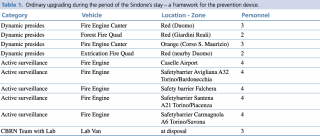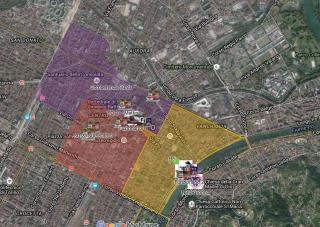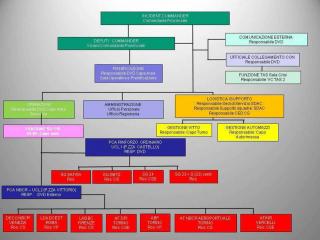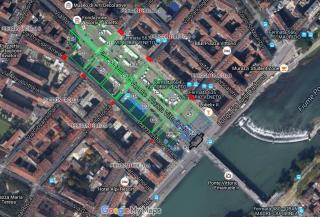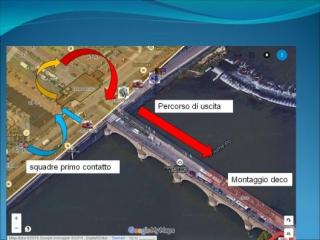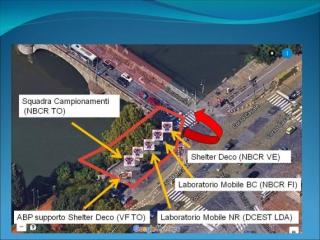Technical Rescue Dynamic Response In High Visibility Events - Operational Concepts And CBRN Aspects
Vincenzo Bennardo,1 Luigi Capobianco,2 Salvatore Corrao3 and Adriana Rinaldi1
1 Ministry of Home Affairs, Italian National Fire Service, Turin Fire Brigade, Central Station, Viale Regina Margherita, Torino, Italy
2 Ministry of Home Affairs, Italian National Fire Service, Central Directorate for Emergency response, Piazza del Viminale, Roma, Italy
3 Ministry of Home Affairs, Italian National Fire Service, Rome Fire Brigade, Central Station, Via Genova 3/A, Rome, Italy
Italian Civil Defense System and Firefighters Role
Law aspects and addresses
The analysis of the risk of terroristic acts is currently being addressed, in compliance with current legislation, within the functions commonly referred to as “Civil Defense”, including all emergencies arising from acts that can be defined as terroristic ones.
It has the task of ensuring the continuity of government action, while protecting the country’s economic, productive and logistical capacity and, on the other, reducing the impact of crisis events on the population. Article 14 of Legislative Decree no. 300 of 30/07/1999 states that the Civil Defense matter is put under the umbrella of Ministry of Home Affairs as well as to the Local Prefectures, who exercise it through the Department of Firefighters, Public Relief, and Civil Defense. Both from the point of view of the media call and of the potential interest of the sites in the key of possible unconventional acts, population recognizes the presence of the firefighters as a state of safeguard, even to prevent, the precious heritage of human life. The purpose of this paper is to identify a method of approach to risk prevention and contrast in general and CBRN in particular in case of major events and/or high visibility events. For these risks, the National Civil Defense Plan has defined the threats, identified the possible scenarios and laid down the measures to be taken.
CBRN Planning – General Prevention and Operational Aspects
Risk scenarios
The specialist literature and in particular the Federal Emergency Management Agency (FEMA) publications1, including surely worth highlighting the document titled “Managing the Emergency of Terrorist Incidents: A Planning Guide for State and Local Governments”2 classifies the types of threat generated by the use of so-called “mass destruction weapons” as defined in their turn as any weapon that is designed or intended to cause death or serious bodily injury through the release, diffusion, or impact of toxic or poisonous chemicals; pathogenic organisms; radiation or radioactivity, or explosion or fire. Among the most credible threat, today as today is the so-called Radiographic Disposal Device (RDD). The terrorist use of an RDD – often called “dirty nuclear” or “dirty bomb” – is considered much more likely than the use of a nuclear explosive device. It can be used by terrorists because it requires limited technical knowledge of a nuclear weapon. In addition, radioactive materials used in RDD are widely used in medicine, agriculture in industry and research, and are therefore easier to obtain than uranium or plutonium.
Critical infrastructures, risk indicators and sensitive targets
Critical infrastructures are material resources, services, information technology systems, networks and infrastructural goods that, if damaged or destroyed, would have serious repercussions on the company’s key functions, including the supply chain, health, the security and the economic or social welfare of the state and of the population. Among the risk indicators, however, particular types of terrorist situations are of particular relevance, which can occur both in relation to the venue of the event and in relation to day and time. A highly visible event taking place in crowded places is by its very nature named a “sensitive target”.
CBRN prevention activity
Compared to the analysis and definition of terrorist risk, it is useful to distinguish between two phases, prevention, and operational response. The response device to a great event must be addressed in both respects. Prevention is aimed at preventing the identification of the main types of events with respect to which intervention procedures can be defined while respecting the specific competencies defined for terrorist risk. In order to ensure good prevention, a CBRN Surveillance Device, apparatus will be required. Given the considerable presence of sensitive targets, all of which are also to be safeguarded, vigilance officers should be alerted to a greater frequency of ordinary checks, taking into account that the infrastructures affected by the possible use of CBRN material are those that ensure water supply and the internal ventilation system to places of great receptive capacity. More specifically, these two elements (air and water) will be checked more frequently in the interior entrances to the internal circuit serving the various components of the air treatment system. The philosophy of a CBRN attack, in fact, requires the use of vectors, or elements that carry the aggressive chemical or pathogenic agent, and that they do so by following the rules of everyday life. The recommendation, for operators and supervisors, is to carefully observe any enclosures found in the vicinity of the air and water inlets; always work with disposable gloves and access the inspected premises with a mask.3,4 CBRN material can be associated with an improvised, conventional explosive device with low explosive potential, useful only as a burst load. The features in the use of improvised ordnance are such that the moment and place of the attack are unpredictable, presumably, it can take place in closed or semi-closed places, given the modest quantities transportable. Agent type, quantity, and property are unknown so it is difficult to estimate the size of an event.
CBRN General Operational Response Concepts for Major Events – Multiple Events and False Alarms
Events that gather a large number of people, such as high visibility events or sporting events of a certain magnitude, have an unusual attractiveness for CBRN matrix terrorist acts and a significant vulnerability. It should be considered that high visibility events, by definition, also focus on media attention, making the psychological and political dimension particularly attractive for a terrorist. The hypothesis of a terrorist attack can only be unconventional (E and CBRN), and it involves serious incidents whose nature is uncertain. This happening is obviously not foreseeable. It cannot be excluded that it simultaneously scatters distinct scenarios, or can be replicated after a short time. It should also be noted that a conventional attack or accident may trigger or mask unconventional aggression. At first, an incident with voluntary use of an aggressive CBRN could manifest itself with features that do not immediately make sense of what is happening. In this regard, an “intermediate scenario” can be defined as a situation in which a preventive and expedient assessment is required both in terms of safety and security before it can be assured with certainty that there is a CBRN risk. “Intermediate scenarios” are often attributable to:
- Presence of suspect vehicles near the places where the big event occurs;
- Suspect parcels or envelopes;
- Perception of miasma and strange odors, smells;
- Great inflows of people who complain of strange symptoms;
and in general to all those situations that are often defined, when they do not evolve, as “false alarms”. False alarms are one of the most debated in CBRN Planning for major events, as the limited resources of the highly specialized Firefighters resources in CBRN are not able to plan frequent and oversized mobilizations compared to the actual risk at the time of the event, and therefore plays a key role in the presence of an effective CBRN prevention device, and an equally effective response device.
CBRN Planning in High Visibility Events
General aspects
The big event schedules must clearly indicate:
- the flow and the ways of communicating the event from the operator to the public rescue services;
- the arrangements for activating the plan by the competent local authority;
- the establishment of an advanced command post where the OSC (On Scene Commander), in the implementation of the aforementioned Directive, will exercise its function of coordinating technical assistance;
- the distribution of expertise between the technical component and health component in the management of CBRN events and that CNVVF personnel adopt, for their chain of command and control of the accident.
To better cover the previous point, the national body of firefighters adopt the “Incident Command System” Model (ICS) – in note no. 6294/24205-EM of 29 July 2005 of the National Fire Corp Emergency Directorate – which has as its object to create a “command and control system for integrated emergency management”.
The determination of the surveillance and rescue CBRN device
From the foregoing, it is evident that it is difficult to obtain an effective CBRN prevention and response device at the site of the major event, resorting solely to the specialist resources associated with the Provincial Command and, later, to the relevant Regional Directorate.
The number of provincial intervention centers and regional decision-makers will be determined and based on the findings of the civil defense plans and the established institutional coordination tables, the location of sensitive sites previously identified, taking into account the capacity to respond and needs of particular attention to public transport terminals and crowded places not directly linked to high visibility events.
The Case of the Sacred Sindony Hosting and Visit of the Pope in Turin
Impact analysis for the event
In the spring of 2015, the Sacred Sindony was again exhibited in the Duomo of Turin from April 19 to June 24, 2015. During the period of the visit on Sunday, June 21, the visit of Pope Francesco to Turin was scheduled for celebrating the Holy Mass in Piazza Vittorio Veneto. The public impact analysis of the event led to the following results:
- 65 days of public attendance (1073 hours) from April 19 to June 24, 2015, about two million pilgrims;
- 3 large parks for tourists;
- 2 pilgrim concentration zones.
The event provided an additional demand for mobility added to the ordinary mobility of the city and the province which was estimated in:
- from 8.00 to 9.00 with 168.000 trips of which 63.000 by public transport and 105.000 by private means;
- from 12.00 to 13.00 with 51.000 private means of transport;
- from 13.00 to 14.00 with 42.000 journeys by public transport;
- from 6 pm to 7 pm with 79,000 private travel trips and 39,000 by public transport.
Considering however that many pilgrims arrived in the city by coach, much of the traffic was mainly concerned with the motorway network, which consisted of the following motorways: Enhancement of Ordinary Rescue Device - Prevention Device.
Turin Provincial Command, on the basis of the available data, sought to have the activation of the risk prevention system envisaged in the following table:
foreseeTable 1. Ordinary upgrading during the period of the Sindone’s stay – a framework for the prevention device.
Pope’s visit on 21 and 22 June 2015 – rescue aid enhancement and CBRN response
Taking into account the particular international context of attacks on the symbols of Christian sacredness during the period of the Sindony, the visit of the Holy Father on 21 and 22 June 2015 at the closing of the demonstrations took on extraordinary character and sensitivity. From the point of view of the media recall and of the potential interest of sites in the key of possible unconventional acts, the Turin Fire Brigade felt essential to integrate the response device at the events with a device, apparatus approved by the Central Directorate for Emergency and Technical Assistance, in Rome.
Enhancement of ordinary rescue device
The visit of the Pope required a special attention in the city of Turin. In order to increase the timely intervention of the rescue teams, temporary fixed and dynamic locations were required, guaranteed by several teams. The conduct of the Holy Mass at Piazza Castello and the consequent modification of the town’s streets in the center made this necessary with the following:
- the redefinition of the territorial competence areas of ordinary firefighters’ team disliking ordinary stations;
- provision of a CBRN extraordinary and autonomous response device for the area of mass, intended as a sensible target;
- extraordinary management of the device in a separate way from the ordinary one, using a mobile operating command post room for resource management, with a communications flow previously defined.
The entire organization of the rescue device was based on the application of an ICS system, with the identification of all the personnel called to perform the assigned functions, according to the scheme described in the following figure:
Figure 1. The planning of the areas of competence of the teams in extraordinary device in the historical center represented by the TAS (Emergency Fire Service Topography Group) core of the on commercial Google map and Applied ICS system (left) – Arrangement of seats for the Mass of the Pope in Turin (right) – June 2015.
Figure 1. The planning of the areas of competence of the teams in extraordinary device in the historical center represented by the TAS (Emergency Fire Service Topography Group) core of the on commercial Google map and Applied ICS system (left) – Arrangement of seats for the Mass of the Pope in Turin (right) – June 2015.
Figure 1. The planning of the areas of competence of the teams in extraordinary device in the historical center represented by the TAS (Emergency Fire Service Topography Group) core of the on commercial Google map and Applied ICS system (left) – Arrangement of seats for the Mass of the Pope in Turin (right) – June 2015.
CBRN strengthening device
During the Pope’s visit in Turin, the Holy Mass of Sunday, June 21, 2015, held in Piazza Vittorio Veneto in the presence of some 50000 people, was considered as the most concerning event from the point of view of attractiveness for a possible act with CBRN material. The previous figure shows the layout of the accommodation structures in the square and, in black, the position of the papal stage. The evening before the Holy Mass, the square was cleared, and the garage below the square severely controlled and cleared too.
The focus of the device was on the possibilities of responding to CBRN event, following the resources disposal as in the next figure
Figure 2. Route Logic DECO CBRN and CBRN disposal Strengthening device – June 2015.
Figure 2. Route Logic DECO CBRN and CBRN disposal Strengthening device – June 2015.
Conclusions
In order to better plan the location and needs for resources in a high visibility event, a prior impact assessment of the event is required. About 90% of the planning effort, for high visibility events, is devoted to CBRN/HAZMAT aspects, but it must be borne in mind that the risk of such an event over the entire spectrum of conventional risks is about 1%. Fortunately, the actual occurrence of CBRN events in case of high visibility events is very low, so a planner must devote a lot of time in planning to deal with situations directly related to the event but affect directly the efficiency of the event, ordinary territorial relief device, yet accepting the challenge of keeping a close eye on the possibility of a CBRN event. In major events, the predominant feature that complicates the accidental response system is the presence of a large number of actors in the field (police, firefighters, healthcare, etc.) each of which tends to deploy men and means by taking into account the factor of numerical coverage, and not of the particular aptitude to ensure adequate responses to the foreseeable scenarios. For example, in the Firefighter’s device, it often recalls that respect to the total potentially deployable forces in the CNVVF field on a national basis for the device to prevent or respond to a major event, there are few realities that have competencies such as CBRN, or realistically more likely scenarios in the event of a terrorist attack.
References
- Dan Kaszeta, CBRN/HAZMAT Assessment Teams for Major Public Events, Strongpoint Security Ltd, London, United Kingdom, 2014
- Special Events Contingency Planning, Job Aids Manual, FEMA, 2005
- Guidelines for First Responders to a CBRN Incident, NATO Civil Emergency Planning, 2014.
- Dan Kaszeta, CBRN and Hazmat Incidents at Major Public Events: Planning and Response, Wiley, 2013



